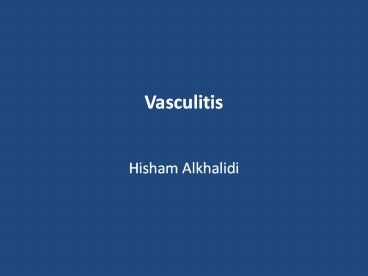Vasculitis - PowerPoint PPT Presentation
Title:
Vasculitis
Description:
Vasculitis Hisham Alkhalidi skin, mucous membranes, lungs, brain, heart, GI tract, kidneys, and muscle can all be involved Disseminated vascular lesions of ... – PowerPoint PPT presentation
Number of Views:290
Avg rating:3.0/5.0
Title: Vasculitis
1
Vasculitis
- Hisham Alkhalidi
2
- Vasculitis
- Vascular inflammatory injury,
- often with necrosis
3
VasculitisCauses
- immune-mediated
- Immune complex deposition
- Antineutrophil cytoplasmic antibodies (ANCAs)
- Anti-endothelial cell antibodies
- Autoreactive T cells
- invasion of vascular walls by infectious
pathogens - Physical and chemical injury
4
Summary of Vasculitides
Vessel Disease Notes
Large Giant-cell arteritis gt50. Arteries of head.
Large Takayasu arteritis F lt40. Pulseless disease
Medium Polyarteritis nodosa Young adults. Widespread.
Medium Kawasaki disease lt4. Coronary disease. Lymph nodes.
Small Wegener granulomatosis Lung, kidney. c-ANCA.
Small Churg-Strauss syndrome Lung. Eosinophils. Asthma. p-ANCA.
Small Microscopic polyangiitis Lung, kidney. p-ANCA.
5
(No Transcript)
6
(No Transcript)
7
Giant-Cell (Temporal) Arteritis
- The most common
- Chronic, typically granulomatous inflammation of
large to small-sized arteries - Principally affects the arteries in the
head-especially the temporal arteries - Rarely the aorta (giant-cell aortitis)
8
Giant-Cell (Temporal) Arteritis
- Unknown cause
- Likely immune origin, T cell-mediated
9
(No Transcript)
10
(No Transcript)
11
(No Transcript)
12
Giant-Cell (Temporal) Arteritis Clinical features
- gt 50 years of age
- Vague symptoms
- Fever, fatigue and weight loss
- May involve facial pain or headache
- Most intense along the course of the superficial
temporal artery, which is painful to palpation
13
Giant-Cell (Temporal) Arteritis
- - Definite diagnosis depends on
- biopsy of an adequate segment and histological
confirmation - - Treatment corticosteroids
14
(No Transcript)
15
Polyarteritis Nodosa
- Systemic
- Small or medium-sized muscular arteries
- But not arterioles, capillaries, or venules
- Typically involving renal and visceral vessels
but sparing the pulmonary circulation
16
(No Transcript)
17
Polyarteritis Nodosa
- all stages of activity (from early to late) may
coexist in different vessels or even within the
same vessel
18
Polyarteritis NodosaClinical picture
- Largely young adults
- Typically episodic, with long symptom-free
intervals - Because the vascular involvement is widely
scattered, the clinical findings may be varied
and puzzling
19
Polyarteritis NodosaClinical picture
- Fever and weight loss
- Examples on systemic involvement
- Renal (arterial) involvement is common and a
major cause of death - Hypertension, usually developing rapidly
- Abdominal pain and melena (bloody stool)
- Diffuse muscular aches and pains
- Peripheral neuritis
- Biopsy is often necessary to confirm the diagnosis
20
Polyarteritis Nodosa
- No association with ANCA
- Some 30 of patients with PAN have hepatitis B
antigenemia - If untreated, the disease is fatal in most cases
- Therapy with corticosteroids and other
immunosuppressive therapy results in remissions
or cures in 90
21
Polyarteritis Nodosa Complications
- Vessel rupture
- Impaired perfusion
- Ulcerations
- Infarcts
- Ischemic atrophy (not infarction)
- Haemorrhages in the distribution of affected
vessels may be the first sign of disease
22
(No Transcript)
23
c-ANCA
24
p-ANCA
25
Antineutrophil Cytoplasmic Antibodies
- Cytoplasmic localization (c-ANCA) -gt the most
common target antigen is proteinase-3 (PR3) - typical of Wegener granulomatosis
- Perinuclear localization (p-ANCA) -gt most of the
autoantibodies are specific for myeloperoxidase
(MPO) - microscopic polyangiitis and Churg-Strauss
syndrome - ANCAs serve as useful diagnostic markers for the
ANCA-associated vasculitides - Their levels can reflect the degree of
inflammatory activity
26
(No Transcript)
27
Microscopic Polyangiitis
- Necrotizing vasculitis that generally affects
capillaries as well as arterioles and venules of
a size smaller than those involved in PAN - Rarely, larger arteries may be involved
- All lesions of microscopic polyangiitis tend to
be of the same age in any given patient - Necrotizing glomerulonephritis (90 of patients)
and pulmonary capillaritis are particularly common
28
Microscopic PolyangiitisPathogenesis
- In many cases, an antibody response to antigens
such as drugs (e.g., penicillin), microorganisms
(e.g., streptococci), heterologous proteins, or
tumor proteins is the presumed cause - This can result in immune complex deposition, or
it may trigger secondary immune responses - p-ANCAs are present in more than 70 of patients
29
(No Transcript)
30
Microscopic Polyangiitis
- Depending on the organ involved, major clinical
features include - Hemoptysis
- Hematuria and proteinuria
- Bowel pain or bleeding
- Muscle pain or weakness
- Palpable cutaneous purpura
31
(No Transcript)
32
Wegener Granulomatosis
- Triad
- Acute necrotizing granulomas of the upper and
lower respiratory tract (lung), or both - Necrotizing or granulomatous vasculitis affecting
small to medium-sized vessels (most prominent in
the lungs and upper airways) - Focal necrotizing, often crescentic, glomerulitis
33
(No Transcript)
34
Wegener Granulomatosis
- 40-50 years
- Without Rx -gt 80 die
- With Rx -gt 90 live (not cured)
- The Rx -gt immunosuppression
35
(No Transcript)
36
(No Transcript)
37
Churg-Strauss syndrome
- Eosinophil-rich and granulomatous inflammation
involving the respiratory tract and necrotizing
vasculitis affecting small vessels - Associated with asthma and blood eosinophilia
- Associated with p-ANCAs.
38
(No Transcript)

